Grenada: January 29-Febuary 10
After our sad goodbyes to Dominica and our long passage to Grenada, we were in need of a moment to collect ourselves. We pulled into Prickly Bay, on the southwest coast of Grenada. It is a large harbor, full of boats, and we could see many swanky new houses, restaurants, and marinas along the shore. It was a far cry from our quiet little Portsmouth, but we didn’t lament. We have the traveling spirit now, so we were excited to see what the Spice Island had in store for us.
We did our usual routine to anchor. We scoped out the harbor and looked for a nice large spot in adequate depth. Chris drives the boat while I handle the ground tackle on the bow. When Chris and I agree on a spot, I lower the anchor. I usually let out five times as much chain as the depth to the bottom. For example, if we anchor in 15 feet of water, I let out 75 feet of chain. There are many factors that might change that ratio, but we use that rule as a starting point.
Then I attach a snubber, also called a bridle. This is a metal fitting that slips over one of the links in the anchor chain. It has a line (rope) attached to each side. One line is secured to our port cleat and the other is secured to the starboard cleat. The snubber relieves the pressure on our windlass, which is the electrical device that lets out and pulls up the chain and anchor. The full weight of our 47-foot boat is pulling against that chain.
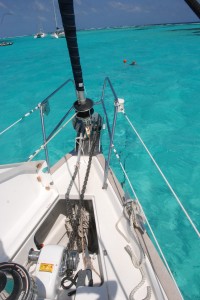
The anchor locker is open to show the windlass. Chris swims out to our anchor bouy, which floats directly above our anchor.
Chris allows the wind to settle the boat and then backs down hard on the anchor to set it into the sand/grass/mud. Finally comes the fun part. I always chuckle when I think about how my “job” is literally to “go swimming”. After we are all settled, one of us dons a mask and “dives on the anchor” to get a visual confirmation that it is dug deeply into the bottom.
It took us a few hours to rest and clean up the boat from our passage. While underway and especially while sailing at night, it is difficult to keep the boat tidy. Food is prepared quickly. Jackets, flashlights, lifejackets, and seaboots are taken on and off throughout the passage and thrown willy nilly wherever they land. The boat bounces around so much that even brushing our teeth is a (messy) adventure. Whenever we finish a passage, it takes at least two hours to get Patronus back in shipshape.
Chris usually takes care of the topsides. He gives the boat a fresh water wash, especially the clear vinyl windows on our dodger, which can erode to a nasty haze with too much salt water (who designed that? windows. on a boat. that can’t get SALT WATER on them?!). He coils up the lines, puts away the fishing gear, hoses down the cockpit (which has tummy-settling pretzel bits all over it), and sets up the dinghy. While underway, we pull the dinghy behind us. The outboard engine is taken off and secured to the stern railing and the gas tank is stored in a compartment in the swim platform.
I take care of down below. I make the beds, gather dirty laundry, hang up wet clothing, do the dishes, and wipe down the tables and counters. We have a few items that must be stowed while underway so they don’t fly around the cabin. I take a moment to set those up again. We have a beautiful tray that our friends, the Cecalas, gave to us and I like to have that on the dinette table. I put the picture frames back up in the stateroom and unhook the bungee cords that keep the printer and books from flying off their shelves. When it is especially rough, I move the cutting boards and collanders from the open shelf under the oven and put them on the floor in Reese’s room.
Reese is in charge of the flags. She raises the courtesy flag for the country we are in along with the yellow “Q” flag, which stands for Quarantine. This flag must be flown when we enter a new country until we clear customs and immigration. She also raises our burgees, which include our Salty Dawg Rally banner, our Ocean Crusing Club flag, our yacht club flags, and our Seven Seas Sailing Association flag. These burgees alert other cruisers to our affiliations and open the door for a dinghy drive-by and a nice hello.
The kids hang up the foul weather gear and store the adult lifejackets, which is a lot harder than it sounds. They also tidy their rooms and help to hang wet clothing. They rinse off, change into clean clothes, and brush their teeth. Bryson assists Chris with the dinghy and might pump up the paddle board and kayak. Then they take out their schoolbooks. It is usually too rough to do schoolwork while the boat is moving, so I get them back on track right away.
On the day we arrived in Grenada, we finished our cleanup, took a deep breath, and readied ourselves for a new country and a new experience. We had made it to our southernmost destination! But first, we had to clear into customs and immigration. Wendy and I took the dinghy in and found the customs office in the upstairs of a small white building. Finding customs is sometimes half the battle, so we were already feeling successful. Customs and Immigration officers run the gamut from “extremely friendly and helpful” to “seriously disgruntled”. We entered the building and heard, “Welcome to Grenada!!!” Good sign.
We began the task of filling out our paperwork. If you have ever flown internationally, you know the skinny immigration forms that you fill out on the plane before you land. We fill out forms like that, designed for maritime use. They ask all kinds of additional boating related questions. Every country is different. Some have one form. Some have up to six forms. Questions cover the basics, like:
Captain name, address
Boat name, type, size, beam, and draft (how deep the boat is in the water)
Previous port and next country of destination
Engine type and horsepower.
How many pets, bottles of liquor and firearms are on board.
Names, birthdates, nationalities, and passport numbers of all crew.
Every once in a while, we are stumped by a vague and badly-worded question, but the officers are usually helpful. While Wendy and I filled out our forms, the Head Customs Guy came in and had a lively, ribbing conversation with the officer. It seems the officer raises chickens at home and had brought fresh eggs in for his manager. The manager was complaining that the eggs were too small. It’s nice to see that chop-busting is alive and well below the Tropic of Cancer. After getting our passports stamped and paying all kinds of fees, we were off to check out the scene. All we found was a tiny superette.
We spent a few days in Prickly Bay, catching up on schoolwork, walking into town, and hanging out on the beach. Wendy and I went on a wild goose chase to find fresh meat at a place that was mentioned in our guide book. We found it, but the supply boat wasn’t bringing new inventory for another week. Instead, the manager sat down with us and gave us several tips on what to do in Grenada, including visiting Merry’s Bakery in Port Louis. We were hoping to do a Hash in Grenada, but the woman had never done it and didn’t know anyone who had. Hmm. More about that later. Back on the beach with the boys, Reese got stung by a jellyfish, but it wasn’t that bad. On the day we left, Reese took her friendship bracelets off and left them on her boogie board so they wouldn’t get wet. Remember that.

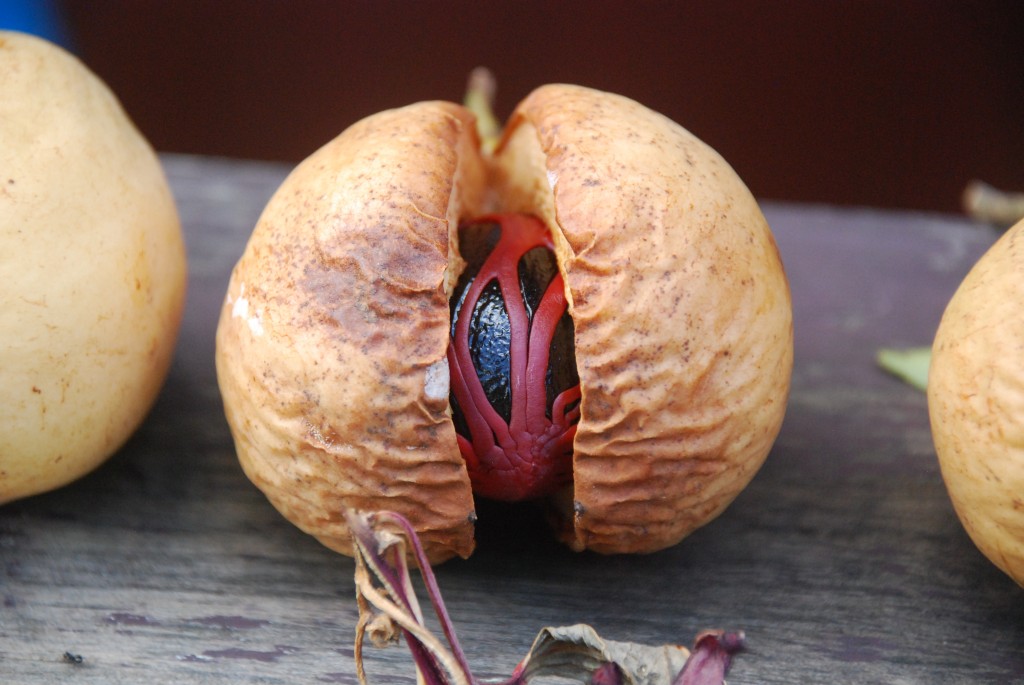
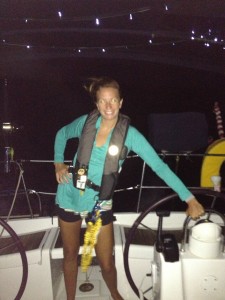
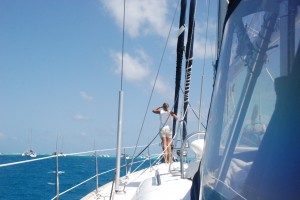
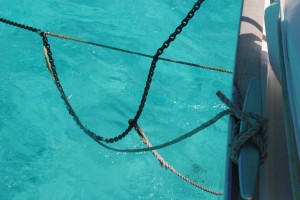
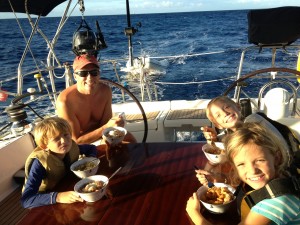
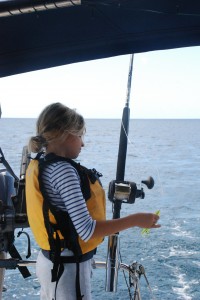
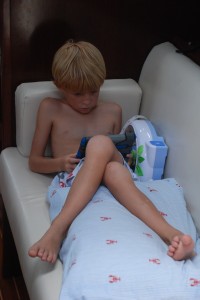
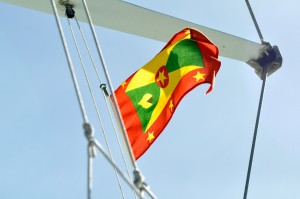
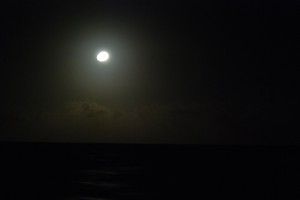
On my way to a work meeting in Phili. Love reading your posts. They make me happy.